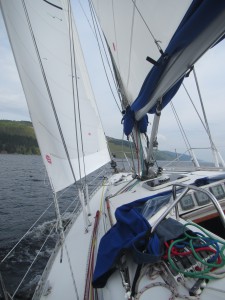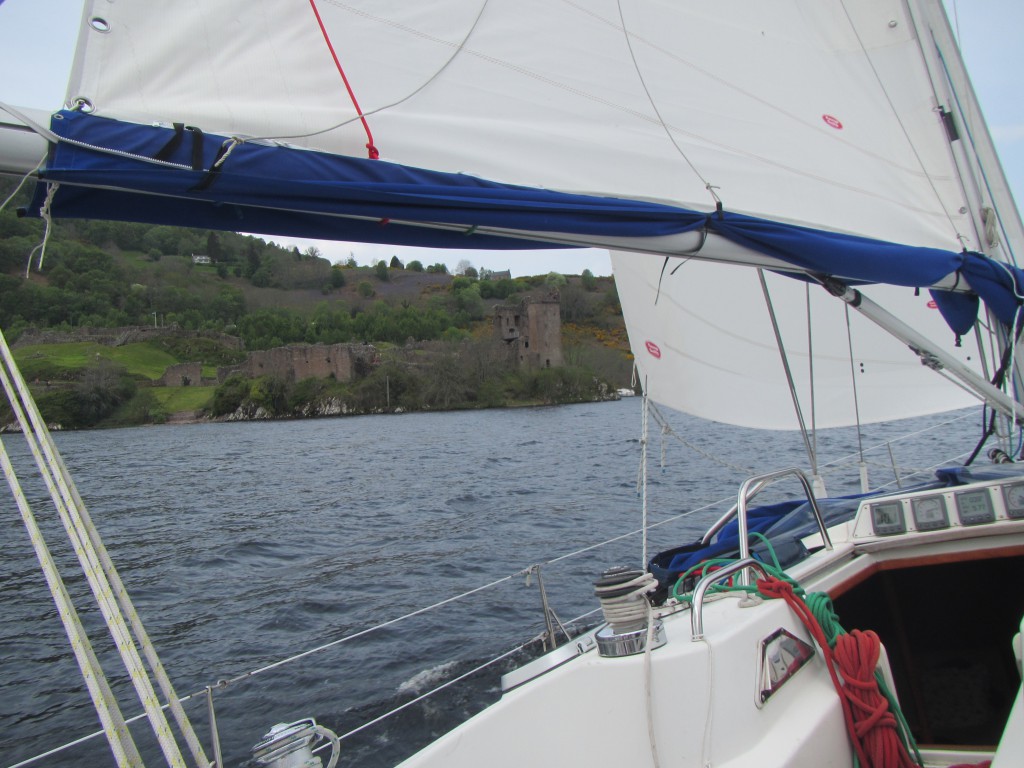Fort Augustus to Inverness – 36.1 miles in seven and a half hours

A great trip today. The weather was better (well dry at least) and though there was almost no breeze overnight, by the time we left Fort Augustus around 08.30am there as a lovely north easterly F3-4 coming down Loch Ness. OK it would have been nice if it had been the same from the SW and we could have had a spinnaker run down Loch Ness, but we weren’t complaining as we had an excellent sail and lots of practice at tacking.
The first 15 miles or so of Loch Ness was remarkable in terms of scenery, but unremarkable in terms of signs of habitation. Wooded slopes, waterfalls falling into the loch and bleak mountains all added to the feeling of being somewhere special. Tacking as we were all the way up the loch, we decided we would tack when the echo sounder read around 50 metres. This may sound idiotic to many east coast sailors, but given that this usually meant we were around 50-100m off the shore, it seemed like a good strategy to avoid running into the rocks!
Around 15 miles up the loch we came to Urquhart Castle. The castle sits on a rocky promontory jutting out into Loch Ness and is apparently one of the most visited castles in Scotland. Around 580AD it was a Pictish Fort and it is said that St.Columba visited there to baptise an elderly Pictish nobleman called Emchath who was close to death. St. Columba was on his way up Loch Ness to visit the King of the Picts at Inverness. In 1296 Urquhart Castle was captured by the English – Edward I being the culprit on this occasion. It then passed backwards and forwards between English and Scottish control over the years and after King Robert Bruce’s death in 1332 was the only castle holding out against the English. Once the English threat had gone, the MacDonalds (Lords of the Isles) arrived and it then alternated between the crown and the MacDonalds. When the last soldiers left in 1692 they blew it up and it has been a ruin ever since. In 1913, it passed to the state and is now run by Historic Scotland.
We did have some strange echo sounder readings on the way through the loch, so it seems likely we were shadowed by Nessie, but he/she (?) never came out to play. We had cameras ready all the way in case, but we would have needed Photoshop to get a picture of Nessie. The stories related to the Loch Ness Monster apparently started in the time of St. Columba and a creature is referred to in The Life of St Columba by Adomnan. St. Columba apparently came across locals burying the body of a man who had been attacked by a ‘water beast’. The term monster though was not really used until 1933 in a report in the Inverness Courier. This led to lots of further reports of sightings and eventually made the national press with the first purported photo appearing in December 1933. The Secretary of State for Scotland then, as a result, ordered the police to prevent any attacks on the monster. Given its non-existence (!), this was presumably something they were happy to do. Further evidence for Nessie was produced on 19th April this year when Apple Maps was showing the monster apparently close to the surface of the Loch. Given their track record for accurate mapping, it must be true that Nessie exists ……
After Loch Ness we headed through Loch Dochfour, through the Tomnahurich swing bridge and down the four locks in the Muirtown flight before mooring at Seaport Marina in Inverness where the boat will now stay for the next couple of weeks.

